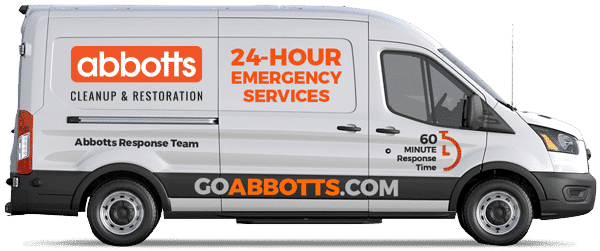FREQUENTLY ASKED QUESTIONS
Helping people & property recover. It's our mission!Our cleanup and restoration experts have the equipment, personnel and know-how to address your damaged property.
About Abbotts
Is Abbotts a licensed contractor?
Yes, Abbotts holds general contractor licenses in all communities throughout Denver, Boulder and Colorado Springs. We are also fully insured, hold BBB A+ Accreditation and are Certified by the Institute of Inspection Cleaning and Restoration. Abbotts is a full service disaster restoration company. One call does it all.
Does Abbotts service my area?
Abbotts operates out of Denver, serves the greater Denver / Boulder area as well as Colorado Springs.
How long has Abbotts been in business?
Abbotts was founded in 2013 by a management team that is comprised of third generation restoration professionals. Our management team has been helping people and property recover from disasters for more than 20 years.
Cost / Pricing
How much does an inspection cost?
Our expertise is at your service. Abbotts cuts through noise and confusion with free inspections and no-cost no-obligation consultations.
How much will my restoration cost?
How much your restoration costs really depends upon the type and the extent of damage. Abbotts uses Xactimate® which independently establishes pricing guidelines. Xactimate® pricing is recognized and accepted as an industry standard by many of the largest insurers and a majority of all insurers. Every item performed on your restoration project is listed in detail and agreed upon by you as well as your adjuster so that there are no surprises. Deviations from the established pricing are documented for review and approval.
Do I need to pay anything upfront?
We will coordinate with and bill your insurance company directly. Typically, the insurance company will pay us directly the full cost of mitigation (e.g. water extraction, drying, dehumidification) since we use the same estimating software and follow industry guidelines. The deductible amount is applied to the reconstruction funds. We will bill you the amount of the deductible once the insurance company cuts you a check for the reconstruction funds, about two weeks after the claim is filed.
Can you bill my insurance directly?
Yes, we can bill your insurance company directly. We have working relationships with major insurance carriers and work with them to coordinate your coverage and our services as well as invoicing and payment. We will let you know what services, if any, are recommended but not covered by your insurance. In most cases, you will only be billed for your deductible.
What if I do not have insurance coverage for my loss?
We do take major credit cards and can work with you on the services. We also offer financing through EnerBank. Also, ask us about our Relief Discount for uninsured damage.
Insurance
Can you bill my insurance directly?
Yes, we can bill your insurance company directly. We have working relationships with major insurance carriers and work with them to coordinate your coverage and our services as well as invoicing and payment. We will let you know what services, if any, are recommended but not covered by your insurance. In most cases, you will only be billed for your deductible.
What if I do not have insurance coverage for my loss?
We do take major credit cards and can work with you on the services. We also offer financing through EnerBank. Also, ask us about our Relief Discount for uninsured damage.
Who needs to be involved in my claim?
As your disaster recovery contractor, Abbotts will work with your insurance company’s claim adjuster to get necessary repair costs approved. Your mortgage company may also get involved to ensure that your property is returned to pre-damage condition. If that is the case, we will provide your mortgage company with all necessary documentation to process your payment and meet their inspection requirements.
What do I need to do to get my claim paid?
We will coordinate with your insurance claim adjuster to get repair costs approved. The insurance company will send you a check for the repair payment, less your deductible. We will bill you for your deductible. We take all major credit cards. This video explains more about the claims process.
Who makes decisions about construction materials for my restoration?
An Abbotts project manager will work with you to help you make these decisions. We only work with reputable suppliers who carry quality materials and can provide a wealth of information on fixtures, flooring, cabinets, appliances and more.
Is my water loss covered by my insurance?
Water damage is usually covered if it is “accidental and sudden”. The insurance may not cover the source of the water (e.g. pipe break or dishwasher leak) but will usually cover ensuing damage and repairs to make the home whole again. Check out this video for more details.
Property Damage
Is my water loss covered by my insurance?
Water damage is usually covered if it is “accidental and sudden”. The insurance may not cover the source of the water (e.g. pipe break or dishwasher leak) but will usually cover ensuing damage and repairs to make the home whole again. Check out this video for more details.
My property is flooded. What should I do?
Time is of utmost importance. Act fast to minimize the damage to your property and prevent associated problems, such as mold infestation. We’ve compiled a Water Damage Emergency Action Guide for steps you can take while you are waiting for our team to arrive.
A sewage leak has contaminated my property. What should I do?
Vacate sewage-contaminated areas right away! Areas with sewage spills should not be occupied by people who are not wearing personal protective equipment as they are dangerous. Turn off electrical power in the area if there is any chance of electrical wires, extension cords or appliances coming into contact with standing water or wet materials. Protect uncontaminated contents from contamination.
What does it mean to mitigate the damage?
The term mitigate or mitigation is a common term in the property damage restoration industry. It is defined as “to make less severe or painful”. Most insurance companies require you to mitigate the damage. For example, water extraction and drying systems are often considered mitigation techniques for water damage. Boardup & securing are mitigation techniques to prevent theft after fire damage.
Is mold really dangerous?
Absolutely, mold is very dangerous. The Centers for Disease Control and other health agencies warn mold spores can cause serious health risks for people with breathing problems. And certain types of mold, including black mold (stachybotrys chartarum) can cause serious health problems, even in healthy people.
How do I get rid of a mold infestation?
DO NOT attempt to clean or mitigate areas affected by mold. You can unknowingly spread mold spores to other parts of the structure, worsening the infestation. One of our trained mold remediation specialists can conduct a visual inspection and other tests to assess the problem. When the extent of the infestation is assessed, your mold remediation specialist will recommend a plan to remove the mold and prevent its return.
How do I restore my fire damaged property?
Safety first. Fire can damage underlying structures making the building unsafe. Abbotts Fire and Flood will perform structural stabilization, board-up and securing services to ensure you, your family and your possessions are safe. While you are waiting for Abbotts to arrive, check out this list of Fire Damage Do’s and Don’ts.
How do I get rid of smoke odor?
Smoke flows through plumbing systems, using holes around pipes to go from floor to floor. Hot smoke migrates to cooler areas and upper levels of a structure. Even a small fire can cause serious smoke damage to your property. Smoke molecules can remain in the pores of materials and continue to release smoke odor and contaminants for years. These odors can easily spread onto clothes, furniture, carpets, and to other parts of the house, especially on a warm day when the high temperatures reopen smoke-filled pores.
The type of smoke will greatly impact the restoration process. Proper deodorizing can spell the difference between big savings and spending thousands of dollars cleaning everything again. Abbotts fire restoration professionals have detailed construction knowledge as well as expertise in smoke removal, odor eradication, soot and ash elimination, stain removal, toxicity removal and restoring balance to the environment.
Abbotts stands behind their work by providing a lifetime warranty against smoke smell and odor recurrence in addition to our standard one-year restoration warranty.
Should I be concerned about lead-based paint?
You are right to be concerned about lead-based paint. The Centers for Disease Control and Environmental Protection Agency warn that lead exposure can cause serious health problems, including birth defects, digestive and nervous system disorders and cardiovascular problems. Children are especially vulnerable to health risks from lead exposure, including brain damage and growth problems. The deterioration of lead paint results in minute lead particles that can be inhaled or ingested. Demolition, sanding and renovation of buildings containing lead paint can also create these hazards. Structures built prior to 1978 were often painted with lead-based paints. Abbotts technicians are trained and experienced in testing for and eliminating health risks from lead-based paints.
The type of smoke will greatly impact the restoration process. Proper deodorizing can spell the difference between big savings and spending thousands of dollars cleaning everything again. Abbotts fire restoration professionals have detailed construction knowledge as well as expertise in smoke removal, odor eradication, soot and ash elimination, stain removal, toxicity removal and restoring balance to the environment.
Abbotts stands behind their work by providing a lifetime warranty against smoke smell and odor recurrence in addition to our standard one-year restoration warranty.
What is asbestos and why is it dangerous?
Asbestos is a durable, fire-retardant fiber that was used extensively in a wide variety of construction materials up until the early 1980s. Extensive research found it to be a highly hazardous cause of lung cancer and other grave illnesses. These materials are not dangerous if they are in good condition and undisturbed. They only become dangerous if the material is disturbed or damaged so that asbestos fibers are released in the air where they can be inhaled. Improper removal may increase the health risks to you and your family. Abbotts highly-trained and certified personnel employs a variety of protocols to control fiber release from asbestos including removal, encapsulation, repair, enclosure, and encasement. Learn more about Abbotts Asbestos Abatement.
How do I find out if my property contains asbestos?
Abbotts conducts a thorough inspection of your property to identify possible asbestos-containing materials. Asbestos is present in a wide variety of building materials including insulation, plaster, floor or ceiling tiles, ductwork, roofing shingles, adhesives, and more. Colorado’s Regulation No. 8, Part B requires testing for asbestos any time more than 32 square feet of drywall or flooring is removed. The state enacted this law to protect property owners, tenants and workers from possible exposure to the hazardous substance. Abbotts coordinates with an independent firm to conduct asbestos testing. Once testing is complete, we develop an abatement plan including removal, encapsulation, repair, enclosure, and encasement. Learn more about Abbotts Asbestos Abatement.
Am I required to remove asbestos from my property?
You can leave asbestos material in place as long as it is undamaged. Asbestos is present in a wide variety of building materials including insulation, plaster, floor or ceiling tiles, ductwork, roofing shingles, adhesives, and more. These materials are not dangerous if they are in good condition and undisturbed. They only become dangerous if the material is disturbed or damaged so that asbestos fibers are released in the air where they can be inhaled. Improper removal may increase the health risks to you and your family. Learn more about Abbotts Asbestos Abatement.
How do I know whether I have to mitigate for asbestos exposure?
Colorado’s Regulation No. 8, Part B requires testing for asbestos any time more than 32 square feet of drywall or flooring is removed. The state enacted this law to protect property owners, tenants and workers from possible exposure to the hazardous substance. Abbotts conducts a thorough inspection of your property to identify possible asbestos-containing materials. Asbestos is present in a wide variety of building materials including insulation, plaster, floor or ceiling tiles, plaster, ductwork, roofing shingles, adhesives, and more. Improper removal may increase the health risks to you and your family. Abbotts works with an independent firm to conduct the testing. Once testing is complete, we develop an abatement plan including removal, encapsulation, repair, enclosure, and encasement. Learn more about Abbotts Asbestos Abatement.
Isn’t asbestos banned in the US?
No. In the late 1980’s a bill passed to ban asbestos products in the US, but this bill was overuled a couple years later, so in some cases, products can still contain asbestos. You can still go to your local hardware store and find a couple of products with asbestos.
Isn’t asbestos only in older homes?
No. Although usage of asbestos in building products is limited, you can still find newly built homes with asbestos products in them. One reason is that building products can be shipped to the US from other countries with different asbestos regulations. We have found homes built in the last few years with asbestos joint compound in them.
Is asbestos only dangerous if its disturbed?
Yes. Asbestos materials can be left in a home and safety stay there for years as long as they are not damaged. Covering or painting over asbestos is a perfectly safe alternative to abatement. The only permanent solution for asbestos is removal though.
As a homeowner, can I remove asbestos myself?
Yes, BUT: The rules say a homeowner can remove asbestos in their own home, as long as it’s their primary residence (home flippers who buy homes to remodel and sell, cannot do their own removal), but then the question becomes, how can you safely dispose of the materials? Most trash haulers strictly regulate disposal of hazardous materials. Also, there is a lot of specialized equipment and procedures needed to safely remove the materials without causing harm to you, your family, your neighbors or the environment. It’s best to hire a certified firm to remove and dispose of the materials.
How do I know its safe to enter the work area after the abatement is complete?
Once all the demo and cleaning has been completed (and the cleaning is very detailed), a 3rd party testing company comes in while all the containments are still up to do a visual inspection. This visual inspection looks for any visible dust or debris that still needs to be removed. If this visual test is passed, then the inspector sets up equipment that pulls air through a pump to be captured, and then a leaf blower is used to attempt to dislodge any invisible asbestos fibers (and be caught by the pumps). Anything caught by the pumps is looked at through a microscope, and if no asbestos fibers are found, then it is deemed safe to enter without protective clothing. Only then can we remove our containment.
How do I know if a building or material contains asbestos?
Some people may look at a material and “think” it contains asbestos, but the only way to know for sure is to have it tested. The best way is to hire a company to do “bulk testing” of the material(s), since hygienists are trained to know what to look for and can do a thorough job of testing all the suspect areas. The 2nd best way is to test the materials yourself by taking sample(s) and either taking or mailing them to a lab to be analyzed.
What should I do with my valuables during my restoration?
We’ll inventory your personal property, pack it up, keep it in a climate controlled storage facility and return it when your property is restored. We ask you to secure jewelry, firearms, important documents and other highly valuable items.





























































